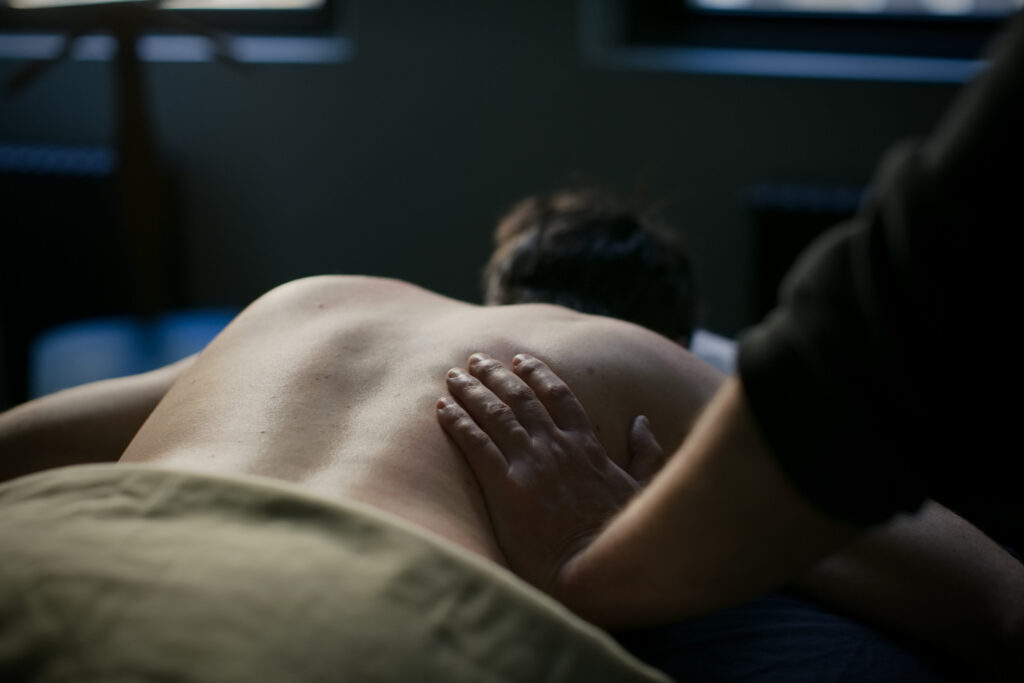YOUR CART
- No products in the cart.
Subtotal:
$0.00
BEST SELLING PRODUCTS
Quick help: Looking for pain relief now? Book a deep tissue massage in NYC at our FiDi or Midtown West studios.
🎥 Watch: how deep tissue differs from other massage styles → Jump to video
New Yorkers push hard. But when you’re hurt, powering through often turns a small problem into a big one. Deep tissue massage can be a game-changer for injury recovery — if you use it at the right stage and with the right approach.
Deep tissue isn’t “harder Swedish.” It’s slower, more specific pressure aimed at deeper layers of muscle and fascia to free adhesions, restore glide, and improve range of motion.
It’s most useful for sub-acute and chronic issues — lingering tightness, guarded movement, scars/adhesions, and patterns caused by older injuries. In the first 48–72 hours after an acute injury, skip deep work on the injured tissue itself.
Related: Our clinical approach blends deep tissue with medical massage and sports massage for long-term results.
What helps now: gentle range-of-motion, light fluid-flushing strokes around (not into) the hot zone, breathwork, and positioning to decrease guarding. These ease pain and improve circulation without aggravating tissue.
Builds gradually, may come/go, often linked to posture or older injuries. This is the ideal time for deep tissue to resolve restrictions and restore normal movement patterns.
Plan: a short series (e.g., 3–5 sessions over 4–8 weeks) to address root causes, then maintenance every 6–8 weeks.

Overuse or improper loading overstretches or tears muscle/tendon fibers. Expect pain, swelling, weakness, sometimes spasm.
Early stage: no deep work directly on the tear. We use gentle ROM, light flushing, and nervous-system calming to reduce guarding.
Sub-acute/chronic: progressive deep tissue, myofascial release, and activation work to restore strength and pain-free range.
Ligaments connect bone to bone and stabilize joints. Grade-1 sprains can still hurt a LOT. Old advice said wall-to-wall ice; newer guidance supports short bouts only and early, pain-tolerant movement.
See our step-by-step ankle sprain recovery guide for details.
Massage approach: avoid deep pressure on the ligament in the acute stage; treat surrounding musculature to reduce swelling and improve joint mechanics.
Microscopic tearing from overuse/repetition. We combine cross-fiber friction (at the right stage) with release of the muscle belly to offload the tendon and speed collagen remodeling.
Working through a running issue? Our Runner’s Massage targets calves, IT band, hips, and feet to address shin splints, plantar fasciitis, and more.
Pro tip: Many clients pair deep tissue with medical massage for complex or long-standing issues.
We see desk-bound professionals, athletes, new parents — and plenty of folks who’ve “tried everything” and want a smarter plan.
Book your deep tissue massage at Bodyworks DW in FiDi or Midtown West. Our intake is thorough and we’ll outline a clear plan for recovery.
Want a clearer definition of deep tissue and where it fits? Watch our Full Guide to All Massage Styles (jump to the deep-tissue chapter).
Hey there! This post could not be written any better! Reading through this post reminds me of my previous room
mate! He always kept talking about this. I will forward this
page to him. Fairly certain he will have a good read. Thank you for sharing!
hi…
You have discussed an interesting topic that everybody should know. Very well explained with examples. I have found a similar website remedial massage near me visit the site to know more about MyoFitness.
Pingback: http://what%20is%20a%20deep%20tissue%20massage
Pingback: http://Massage%20Benefits%20for%20Muscular%20Strains%20|%20Recovery%20Guide%20-%20Suite%20Massage%20Chairs%20|%20Massage%20Chair%20Reviews
Pingback: http://how%20can%20massaging%20muscular%20strains%20be%20harmful
Pingback: